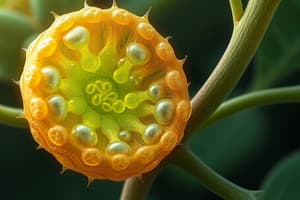Podcast
Questions and Answers
What is the role of plastids in meristematic cells?
What is the role of plastids in meristematic cells?
- They are undifferentiated, but present in rudimentary form (proplastids) (correct)
- They are fully differentiated and specialized for photosynthesis
- They have no role in meristematic cells
- They help in water absorption from the soil
What is the function of meristematic cells in plants?
What is the function of meristematic cells in plants?
- They help in water transport within the plant
- They store energy for the plant
- They provide new cells for expansion and differentiation of tissues (correct)
- They provide support to the plant body
What is the main characteristic of meristematic cells?
What is the main characteristic of meristematic cells?
- They have fully developed chloroplasts
- They have large vacuoles and protoplasm
- They are differentiated and cannot divide
- They are totipotent and capable of continued cell division (correct)
Why are meristematic cells packed closely together without intercellular spaces?
Why are meristematic cells packed closely together without intercellular spaces?
Who first used the term 'meristem' in 1858?
Who first used the term 'meristem' in 1858?
Flashcards are hidden until you start studying
Study Notes
Meristematic Cells in Plants
- Plastids in meristematic cells are small, undifferentiated, and lack pigments, allowing them to differentiate into various types of plastids later in development.
- Meristematic cells are responsible for plant growth and development, producing new tissues and organs through cell division and differentiation.
- The main characteristic of meristematic cells is their ability to divide and differentiate into various cell types, making them capable of continuous growth and development.
Structure and Organization
- Meristematic cells are packed closely together without intercellular spaces, allowing for efficient cell-to-cell communication and coordination of growth and development.
History of the Term 'Meristem'
- The term 'meristem' was first used by Carl Wilhelm von Nägeli in 1858 to describe the undifferentiated cells responsible for plant growth.
Studying That Suits You
Use AI to generate personalized quizzes and flashcards to suit your learning preferences.




